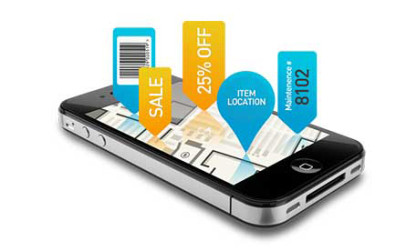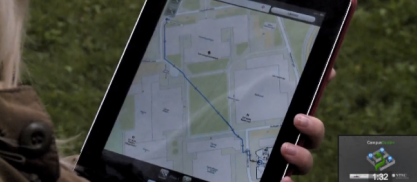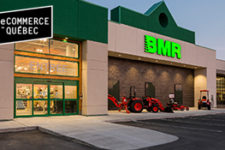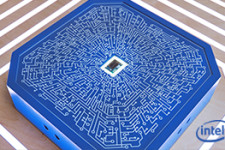But soon marketers will be able to interact with each consumer and leverage the same data that they are used to when managing websites and online ad campaign even in-stores. By using localization tactics in retail environment to compensate the fact GPS doesn’t work indoors, businesses will have the ability to create relevant content and access a wide range of new metrics to improve their marketing strategy and tactics.
Early Days of Localization Tactics
Let’s go back couple years ago to better understand the current opportunities. In 2010-2012, marketers saw the rise of a new buzz word “SoLoMo” which stands for Social, Local and Mobile. 3G service was becoming the norm as well as smart phones so new apps were created allowing users to check into locations that they visited using their mobile device. Gowalla and Foursquare paved the road for others.
all platforms relied on voluntary “check in” from users
The two biggest barriers that localization – or location based services – faced at the time were that all platforms relied on voluntary “check in” from users and the precision of the data was very limited. Marketers still were getting a new way to engage with their consumers (badges, offer for mayors..) and more insights on their consumers (comments and tips, basic data around check-ins..) but it was only a taste of the localization tactics and tools now available. Passbook has been on the verge of the upcoming progress with it’s location and time triggers.
Tech shift: Indoor Positioning System (IPS)
The leap forward in the past months came from 2 innovation trends. The first one being the on-going improvement of smart phones: mass adoption, extended battery life, improved sensors (Wifi, Bluetooth, NFC). The second trend is the recent ability to locate indoors with pin point accuracy and below are outline several ways to achieve it:
- Wi-Fi triangulation: Consumers’ smartphones emit radio signals and unique identifiers
- Bluetooth Low Energy (BLE): iBeacons
- Radio localization: low powered radios
- Lights and Magnetic fields: invisible lights pulses to communicates with smartphones cameras
- RFID: micro chip acting as a barcode
- Sensor Tracking: combo of gyroscope, accelerometer and compass
Regardless of the technology used, they are benefits to indoor tracking and localization tactics for both consumers and marketers.
Consumers’ Application
What’s in for me? will ask the average consumer. The simple answer is more relevant content when indoor.
Acting as iBeacon, a user with an iOS 7 device in hand could trigger events around them, allowing them to signal the user’s proximity to devices listening for it via BLE. They might not be life-changing benefits for individual consumers at the moment and the initial used cases so far are focused in retail, where there is a big opportunity to push relevant offers and promotions to consumers as they approach certain items or if they have been in range for long enough.
Indoor mapping and guides:
- On campus, in hospitals and malls and other stores, consumers will be able to access floor plans from their phones to enhance their navigation: find a class room, a store, your car on a parking lot..
- Coupled to additional technologies, they could also be directed to specific destinations such as a shorter line or the closest cash register.
- Museum and galleries can also leverage the technology to deliver extra content when a consumer walks by a specific art piece.
Give apps more context:
- automatically log you in/out apps or account as you are within a beacon range (workplace/home) or create “notification free” zones while you are driving for instance.
- IFTTT-style use cases – beacons could be used to trigger custom actions like “If I go to the gym, add an entry to my FitBit daily log saying so, and record how long I spent there.”
- LBE powered Arduino: now almost anything can be the trigger to a notification or action in any app.
Home automation:
- use your phone to detect which room to turn the light on/off
- Never lose anything again: add a physical beacon to things that matters
Public transit real time adjustments:
- detect precisely how many passenger are waiting at a given bus stop and re-affect bus allocation to match demand.
So indoor localization technology doesn’t have to be about commerce or advertising.
Marketers’ Benefits:
But as one can imagine, there are plenty of reasons for marketers to jump on these new innovation and unleash the potential of localization tactics.
Indoor Positioning Systems bring Internet-style tracking to physical spaces.
Recent implementations from the Miami Dolphins at the Sun Life Stadium in Florida and Major League Baseball across its stadiums showed how localization technologies are used to deliver a targeted mix of indoor mapping paired with exclusive content and promotional offers.
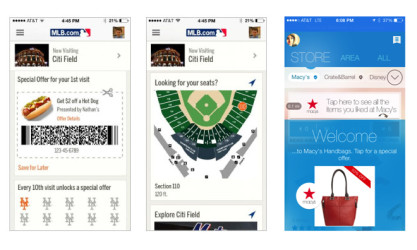
Localization technologies allow marketers and advertisers to gather better insights on consumers behavior and therefore create a deeper and more effective targeting in the content/ad they create. Like cookies, beacons can’t transmit any “non-personally identifiable information” about the user (name, email..) but a string of informations such as time of visit, time spent on site, device, apps installed on your phone, other locations you might have visited.. So without telling who you are, marketers will quickly be able to create or validate user persona.
For example, a device observed at a Whole Foods on a weekday morning, at a soccerplex on a Saturday morning, and at a nearby suburban mall on a weekday afternoon is likely owned by a member of the target audience segment. Other data, such as the demographics of the neighborhood in which the device is observed or the types of retailers in the mall, might also inform the segmentation
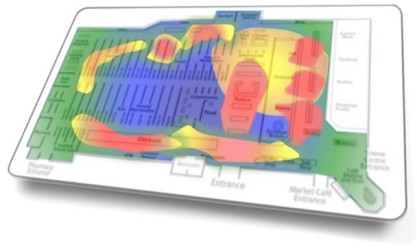
The data collected ultimately makes It will also make marketers more knowledgable on indoors patterns. Whether it’s used to raise the rent of a store in a mall or decide to give you a 10% discount, the technology will be used to further track consumer’s information.
To some extent, hyper targeting and localization tactics might be a way to lure back those who have shifted to buying online. By introducing some personalization elements in store, retailers could compete with recommendations, convenience and price.
Future Trends
For the media and advertising industries, IPS and other localization tactics are a form of targeting that has proven to deliver better results (high CTR) so we can expect them to keep investigating the topic. Brands are also testing the water with this new technology and nothing should be taken for granted.
But once the players solve the problem of the multi screen cookie, one can only imagine how far the targeting (and retargeting) will go: from a google search on your desktop, brand will serve you ads on your phone and potentially tailor their offer once in your favorite store. This is what one can call enhanced sequential advertising and it will use indoor localization tactics.
We have heard (but not seen yet) ideas where consumer online profile will be paired with an branded beacon given to the consumer. Once in store, every associate or digital POS could access this data to deliver a personalized experience. No app download required.
Additional Thoughts on Privacy
Privacy policies tend to be vague and misleading. They allow “Affiliated Partners” to collect data which may include consumer information about their online activities over time and across third-party sites or services.
Since there will be few people to read the fine print in the upcoming apps leveraging these technologies, we can foresee shaddy marketers abusing this data tracking to by pass the “non-personally identifiable” rule.
Academic research shows that the combination of ZIP code, birthdate, and gender—all “non-personal information”—is unique for about 87 percent of U.S. residents. (Electronic Frontier Foundation) That means if an app has this data, it usually has enough that you can be individually identified.
Consumer might be willing to trade off data for discounts and tips but they do not realize the amount of data that could potentially be collected about them via an iBeacon-based system. If they feel that they are being tracked/cheated by brands or if they find out that they are mapping out their personal data, they will delete apps and deny access to location tracking.
A Better Internet?
It’s hard to say if these new technology will benefit the world. Like most new technologies, there is less oversight and control of when and where your information is being tracked. In my opinion, marketers will far more benefit more from it than consumers, or at least in the short term.
I have hope that individuals can quickly have access to easy way to play with it (IFTTT, Arduino) so that we don’t associate this technology as a new evil from the Internet Mall.
Additional references and further readings:
- Macy’s flagship store or American Eagle 100’s stores powered by the Shopkick app
- LBE powered Arduino: : https://launch.punchthrough.com/
- Hone automation: Tile: http://www.thetileapp.com/
- Hospital and Universities: https://use.mazemap.com/
- Top beacons suppliers: http://beekn.net/guide-to-ibeacons
- CES scavenger Hunt: http://bit.ly/1c09eFN (and how it was hacked)
- Kick Pub in London provides free content through beacons as incentive to bring customer in (under the form of magazines in Newsstand)


